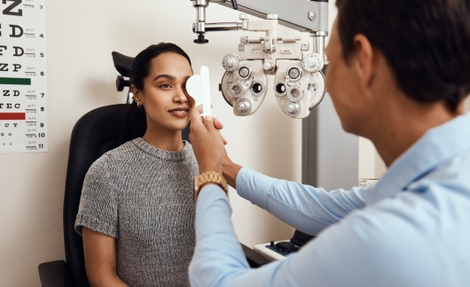How Good Is Your Vision? 5 Chronic Health Conditions That Can Be Detected Through Eye Exams – Blue Shield of California | News Center
by Kahliah Laney Eyes may be”the window to the soul,” but as it turns out, the eyes can also tell a lot about a person’s overall well-being. “Eye exams don’t only help detect issues with your vision or eye health, but can also help identify other chronic health issues like diabetes, heart disease and even…
by Kahliah Laney

Eyes may be”the window to the soul,” but as it turns out, the eyes can also tell a lot about a person’s overall well-being.
“Eye exams don’t only help detect issues with your vision or eye health, but can also help identify other chronic health issues like diabetes, heart disease and even some autoimmune diseases,” said Dr. Scott Flinn, regional medical director for Blue Shield of California Promise Health Plan.
August is National Eye Exam Month — and it’s a great reminder to get your routine eye exam. While it’s recommended that adults have their eyes checked every one to two years, only 50% of adults in the U.S. report getting an annual exam, even though the visit to the eye doctor is just as important as an annual physical. Below, learn more about which diseases can be detected during our annual eye exams.
1. Diabetes

Dr. Scott Flinn, Blue Shield of California
Diabetic retinopathy, an eye disease caused by diabetes, can be present in the eye tissue before an individual has even been diagnosed. For individuals who have already been diagnosed with diabetes, an annual eye exam is even more important to help catch and manage other diabetic-related eye diseases, like glaucoma and diabetic retinopathy, a leading cause of preventable blindness.
“There is a direct relationship between blood sugar levels and eye health, so keeping your blood glucose in a safe range helps maintain healthy eyes,” said Dr. Flinn. “Individuals with diabetes should plan to have an annual diabetes-specific eye exam.”
2. Hypertension
According to the National Heart, Lung and Blood Institute, about half of all Americans have hypertension, or high blood pressure, but people often don’t experience symptoms. “During an annual eye exam, you’ll typically have your eyes dilated so that the eye doctor can check the back of your eyes — your retina and optic nerve,” said Dr. Flinn. “Blood vessels that are too large or too thin may indicate high blood pressure.”
3. Heart disease
The American Academy of Ophthalmology found that heart disease may be detected using a developing technology during comprehensive eye exams. “Individuals who have heart disease may have retinas that show evidence of eye stroke,” said Dr. Flinn. “This is the result of reduced blood flow and oxygen to the eye which eventually causes eye cells to die.”
4. High cholesterol
High cholesterol can increase the risk of what’s called retinal vein occlusion, a serious condition that impacts eye function causing blurry vision, floaters and eye pain. High cholesterol can also impact the appearance of your eyes. Xanthelasma, a condition that causes your skin to turn yellow and raise around the eyes, is a build-up of cholesterol underneath the skin. Arcus senilis is another eye condition that can also indicate high cholesterol — a blue, white or gray discoloration forms a ring around the outside of the front of your eye as a result of cholesterol in your cornea.
5. Sjogren’s syndrome
An autoimmune disease, Sjogren’s syndrome is a disorder that causes decreased tears and saliva, leading to dry eyes and dry mouth. The disorder is usually associated with other immune disorders like rheumatoid arthritis and lupus. According to the Mayo Clinic, the condition is the result of your body’s immune system attacking its own tissues and cells. An eye exam will determine tear production as well as damage to the cornea. “Dry eyes may be one of the first symptoms that people with Sjogren’s syndrome experience,” said Dr. Flinn. “So, an eye exam could be critical in early detection of this condition.”
Optometrist or ophthalmologist?
Before scheduling your annual eye exam, it’s important to make sure you’ve selected the right kind of eye doctor. According to the American Academy of Ophthalmology:
- An ophthalmologist is a medical doctor with either an MD or DO (doctor of osteopathic medicine). They perform advanced eye care and surgeries.
- An optometrist is not a medical doctor, but are called “eye doctors” because they hold doctor of optometry (OD) degrees. They can typically provide routine vision and eye care.
For a routine eye exam, which could potentially identify any of the conditions listed above, you’d want to see an optometrist.
“Routine eye exams are about more than getting a new prescription for eye glasses or contacts,” said Dr. Flinn. “They are really a component of preventive health and critical to early disease detection and prevention.”
Resources




